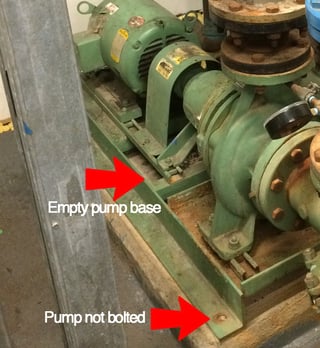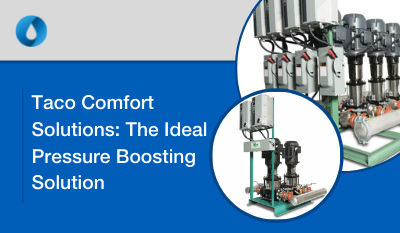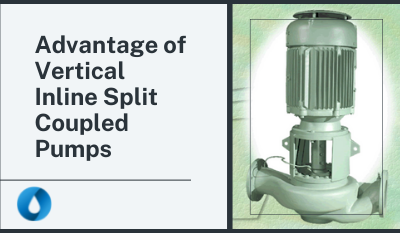Some might argue that pumps are the most vital component of a commercial HVAC system. Just as the body cannot live without the heart to pump blood, a building cannot heat or cool without the pumps doing their job. Boilers, chillers, cooling towers, air handlers, terminal units, radiant devices, etc. are all useless without water flowing through them. (Yes, air handlers and other fans can provide ventilation, but the air would be unconditioned. You might as well open a window and hope for a breeze!)
Whether you are a contractor, engineer, or building owner, making sure your pumps are installed correctly is really easy IF you know what to look for. Here are the five most common installations mistakes we see on base mounted end suction pumps.
Number One: Pump Base/Frame Not Grouted & Bolted
Important because:
- If your pump bases/frames are not grouted and bolted, you increase noise transmission to the building.
- Additionally, grouting and bolting assists with pump stability. A stable pump lasts longer!
How to spot it:
- Empty pump base
- Pump not bolted to the housekeeping pad
- Excessive Noise/Vibration Transmitted from the Pump
Solution: Securely bolt the pump base to a LEVEL housekeeping pad, then fully fill the pump base with grout to the top of the frame.
Number Two: Pipe Weight On the Pump Volute
Important because:
- External weight causes stress on the pump, creating misalignment in the shafts.
How to spot it:
- Premature failure of bearings & seal
- Suction diffuser or suction piping not supported
- Adjacent flex connectors are squashed
- Pipe hangers missing or improperly secured to the pipe
Solution: Tighten and secure adjacent pipe hangers. Add support stands to suction diffuser or suction piping.
Number Three: Pump and Motor Shafts Not Skillfully Aligned
Important because:
- Shaft misalignment leads to premature bearing failure, coupling failure, and other issues.
How to spot it:
- Vibration and noise
- Frequent pump and/or motor bearing failure
- Coupling wear and failure (see the black shavings laying under the coupler?)
- Do you see shims under the motor foot and pump wet end? If not, then it has NEVER been aligned!
Solution: Dial caliper or laser alignment (best) by a skilled pump technician or millwright. Final alignment can only be done AFTER #1 & #2 above are addressed and the system is running and up to operating temperature.

Number Four: Seal Flush Lines Not Installed
Important because:
- The water in the pump lubricates the mechanical seal. The flush line brings cooler water to the seal and pushes dirt and debris away from this area of no circulation within the volute.
How to spot it:
- Water on the floor or spraying from mechanical seal failure
Solution: Install a copper line from the seal flush tapping on the pump. A good pump manufacturer will provide the tappings and/or flush line as part of their standard offering.
Number Five: Too Many Pressure Gauges, and Reading from Incorrect Ports
Important because:
- Proper gauge configuration is required to accurately troubleshoot and determine the performance of the pump.
- Gauges must be connected to the correct test ports to get a true reading ONLY of the differential across the pump, and NOT other piping and components.
How to spot it:
- More than one gauge installed at the pump, which introduces the gauges inaccuracies in the pressure differential readings.
- Gauges NOT connected to designated inlet and outlet ports on the pump. Common examples are the external piping, volute air bleed port, or seal flush line connection.
Pumps that are correctly installed should require little maintenance, be easy to troubleshoot, and last for most of the life of the building (25 years or more). Were your pumps installed properly? Take just a minute to walk through your mechanical room, and look for some of the symptoms mentioned above. If you see something wrong, you know who to call!
Industry education is important to us. Do you want to learn more about simple piping systems? Click below!




.png)




Submit a Comment